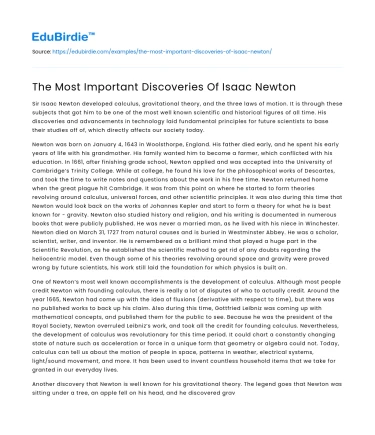Sir Isaac Newton developed calculus, gravitational theory, and the three laws of motion. It is through these subjects that got him to be one of the most well known scientific and historical figures of all time. His discoveries and advancements in technology laid fundamental principles for future scientists to base their studies off of, which directly affects our society today.
Newton was born on January 4, 1643 in Woolsthorpe, England. His father died early, and he spent his early years of life with his grandmother. His family wanted him to become a farmer, which conflicted with his education. In 1661, after finishing grade school, Newton applied and was accepted into the University of Cambridge’s Trinity College. While at college, he found his love for the philosophical works of Descartes, and took the time to write notes and questions about the work in his free time. Newton returned home when the great plague hit Cambridge. It was from this point on where he started to form theories revolving around calculus, universal forces, and other scientific principles. It was also during this time that Newton would look back on the works of Johannes Kepler and start to form a theory for what he is best known for - gravity. Newton also studied history and religion, and his writing is documented in numerous books that were publicly published. He was never a married man, as he lived with his niece in Winchester. Newton died on March 31, 1727 from natural causes and is buried in Westminster Abbey. He was a scholar, scientist, writer, and inventor. He is remembered as a brilliant mind that played a huge part in the Scientific Revolution, as he established the scientific method to get rid of any doubts regarding the heliocentric model. Even though some of his theories revolving around space and gravity were proved wrong by future scientists, his work still laid the foundation for which physics is built on.
Save your time!
We can take care of your essay
- Proper editing and formatting
- Free revision, title page, and bibliography
- Flexible prices and money-back guarantee
One of Newton’s most well known accomplishments is the development of calculus. Although most people credit Newton with founding calculus, there is really a lot of disputes of who to actually credit. Around the year 1665, Newton had come up with the idea of fluxions (derivative with respect to time), but there was no published works to back up his claim. Also during this time, Gottfried Leibniz was coming up with mathematical concepts, and published them for the public to see. Because he was the president of the Royal Society, Newton overruled Leibniz’s work, and took all the credit for founding calculus. Nevertheless, the development of calculus was revolutionary for this time period. It could chart a constantly changing state of nature such as acceleration or force in a unique form that geometry or algebra could not. Today, calculus can tell us about the motion of people in space, patterns in weather, electrical systems, light/sound movement, and more. It has been used to invent countless household items that we take for granted in our everyday lives.
Another discovery that Newton is well known for his gravitational theory. The legend goes that Newton was sitting under a tree, an apple fell on his head, and he discovered gravity. Newton realized that there had to be some force acting on all matter, so that the moon didn’t get pulled out of orbit, apples fall, etc. He called this force “gravity”, and started to study how it affected all matter. Using this concept, Newton was able to prove the heliocentric model that Galileo, Brahe, and Kepler had made. The gravitational theory states that every mass attracts every other mass in the universe, and the force of gravity between those two masses is directly proportional to the product of their masses and indirectly proportional to the distance squared between them. This theory has been used for years after its discovery, one example being used to predict the planet Neptune’s discovery. Using the gravitational theory, scientists realized that there had to be another planet putting gravitational force on Uranus due to the unusual orbit, and sure enough, Neptune was discovered in 1846.
One final accomplishment that Newton is well remembered for is his discovery of the three laws of motion. He developed these laws in 1666 at the age of 23. In 1687, he documented these laws in “Principia Mathematica Philosophiae Naturalis”. The first law states that objects will stay in motion unless acted upon by another force. The second law states that the more force exerted on an object, the more that object will accelerate. The third law states that every action has an opposite and equal reaction. These three laws represented a great aspect of nature by using simple math formulas, which laid a solid foundation for later physicists to base studies off of. They are used in our everyday lives, and can tell us exactly how long something will remain still or moving, why humans don’t float away from the earth, and more.
In conclusion, Isaac Newton’s development of calculus, gravitational theory, and the three laws of motion are some of the most important discoveries that took place during the Scientific Revolution. He was able to chart changing states of nature like never before, explain how mass is attracted to each other via the gravitational theory, and show how simple mathematical formulas can be used to create laws that serve as the foundation of physics. It is no question that Newton was one of the biggest minds during the Scientific Revolution, and without him, we would not have fundamental principles to base scientific research off of today.






 Stuck on your essay?
Stuck on your essay?

